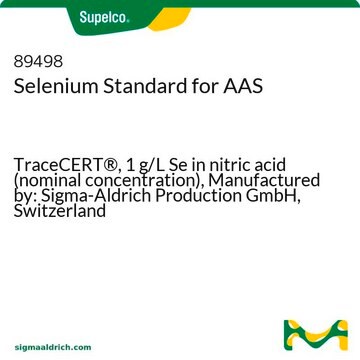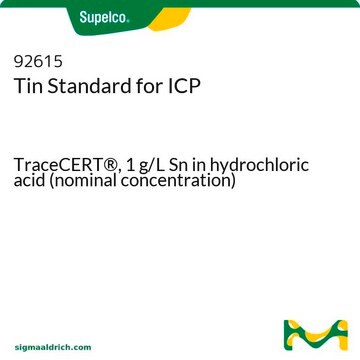推荐产品
訊號詞
Warning
危險分類
Eye Irrit. 2 - Met. Corr. 1 - Skin Irrit. 2 - STOT SE 3
標靶器官
Respiratory system
儲存類別代碼
8B - Non-combustible corrosive hazardous materials
水污染物質分類(WGK)
WGK 1
閃點(°F)
Not applicable
閃點(°C)
Not applicable
Matthew Currie et al.
Inorganic chemistry, 52(4), 1710-1721 (2012-06-09)
The anionic speciation of chlorostannate(II) ionic liquids, prepared by mixing 1-alkyl-3-methylimidazolium chloride and tin(II) chloride in various molar ratios, χ(SnCl2), was investigated in both solid and liquid states. The room temperature ionic liquids were investigated by (119)Sn NMR spectroscopy, X-ray
Najmadin Azizi et al.
TheScientificWorldJournal, 2012, 908702-908702 (2012-06-01)
A simple deep eutectic solvent based on tin (II) chloride was used as a dual catalyst and environmentally benign reaction medium for an efficient synthesis of 3,4-dihydropyrimidin-2(1H)-one derivatives, from aromatic and aliphatic aldehydes, 1,3-dicarbonyl compounds, and urea in good-to-excellent yields
Caitian Gao et al.
Nanoscale, 4(11), 3475-3481 (2012-05-11)
A high-efficiency photoelectrode for dye-sensitized solar cells (DSSCs) should combine the advantageous features of fast electron transport, slow interfacial electron recombination and large specific surface area. However, these three requirements usually cannot be achieved simultaneously in the present state-of-the-art research.
Qiu-Sha Tang et al.
International journal of nanomedicine, 6, 3077-3085 (2011-12-14)
The purpose of this study was to develop intraperitoneal hyperthermic therapy based on magnetic fluid hyperthermia, nanoparticle-wrapped cisplatin chemotherapy, and magnetic particles of albumin. In addition, to combine the multiple-killing effects of hyperthermal targeting therapy, chemotherapy, and radiotherapy, the albumin-nanoparticle
Liyan Zheng et al.
Dalton transactions (Cambridge, England : 2003), 41(5), 1630-1634 (2011-12-08)
It was found that stannous chloride (SnCl(2)), as a popular inorganic reducing reagent, could obviously enhance the electrochemiluminescence (ECL) of tris(2,2'-bipyridyl) ruthenium(II) (Ru(bpy)(3)(2+)) in aqueous solution. Some factors affecting the ECL reactions between Ru(bpy)(3)(2+) and Sn(2+), including pH, concentrations of
我们的科学家团队拥有各种研究领域经验,包括生命科学、材料科学、化学合成、色谱、分析及许多其他领域.
联系技术服务部门








